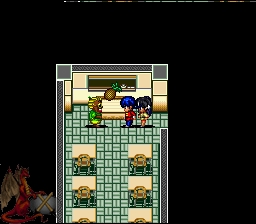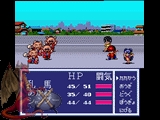|
|

|
PLATFORM
|
SNES
|
BATTLE SYSTEM
|

|
INTERACTION
|

|
ORIGINALITY
|

|
STORY
|

|
MUSIC & SOUND
|

|
VISUALS
|

|
CHALLENGE
|
Very Easy
|
COMPLETION TIME
|
Less than 20 Hours
|
|
OVERALL

|
+ Easy to play
- Terrible menus
- For Ranma 1/2 devotees ONLY
- Boring to play
|
Click here for scoring definitions
|
|
|
Ranma 1/2 is a manga by Rumiko Takahashi that became a lengthy anime. Its title character, Ranma Saotome, has the unfortunate affliction of turning into a girl every time he is splashed with cold water. Hot water undoes this however. His father Genma has a similar affliction, only Genma turns into a panda with cold water's application. Ranma is betrothed to Akane Tendo, the daughter of his father's good friend Soun, and the two of them bicker constantly but just might have the flicker of romance deep down. Ranma's rival Ryoga also has feelings for Akane, though he never voices them, and is afflicted with turning into a piglet when wet. Ranma is also engaged to Shampoo, a Chinese Amazon who he (while a she) bested in single combat. Shampoo has the affliction of turning into a cat when wet, and she is pursued by a fellow named Mousse who turns into a duck when wet. Ranma has a third fiancee named Ukyo (courtesy of his father wanting her dowry), and she is cursed with nothing but a talent for making okonomiyaki. Akane is pursued at school by Kuno and Ranma by Kuno's sister Kodachi, and everyone at school is embittered towards Kuno and Kodachi's father the Hawaii-obsessed principal.
That outline is not terribly helpful to one who is unfamiliar with the Ranma universe, but it is more information than this Super Famicom title imparts. It more-or-less follows the rules of filler that long-running anime are bound to observe, with a new threat being unearthed in the introduction by the Jusenkyo guide. This threat turns out to be an evil cat gang that kidnaps Genma, who in his panda form is somehow necessary to their plans. Ranma and Akane set off to rescue Genma, Ryoga and Shampoo join in pretty quickly, and a party of four runs around battling the evil cat gang. Aside from glossing over Ranma's pathological fear of cats save in a single instance (the fear of cats came from his father repeatedly tying meat products around his son and throwing him into a locked room filled with felines) the plot is slow and filler-laden even by the standards of a filler plot. Shampoo and Akane cooperate much too readily for my liking, also.
 The explosive pineapple - used by Hawaii to combat invasion for sixteen centuries.
The explosive pineapple - used by Hawaii to combat invasion for sixteen centuries.
|
|
The actual playing of Akanekodan Teki Hihou will be very easy for any RPG veterans. Random battles will pop up as Ranma and compatriots wander around, with standard attack, ki use, items, defense and running being the options for the player to choose from as the party enters turn-based combat. The turn order is respectably consistent in this game, though it can be a bit random sometimes. There are two major tweaks to the standard turn-based formula here: one is that every character has a set amount of Ki that does not increase throughout the game, but Ki does regenerate simply by walking around. The second is the player's ability to hit X, which initiates a gigantic dust cloud in the center of the screen straight out of a Chuck Jones cartoon, and both sides will smack each other around until a winner is left standing. While fun to look at, this feature will deliver quite a few Game Over screens thanks to its random nature. The ability to change everyone but Akane into their cursed forms does not really count, because this is only necessary for a few plot points and everyone performs better in human form anyway (Ryoga cannot peform most of his Ki techniques as a piglet).
Interaction in Akanekodan demonstrates a certain cluelessness on the part of Rumic Soft. There is the fact that Ki techniques have no descriptions to announce what they do, which means a good memory is necessary. That is a minor flaw however, compared to shops announcing what items do but these item descriptions being inaccessible outside of a shop. This aspect is not enough to tax the player's memory, so equipping any character becomes an exercise in short-term memory. When looking through a shop's equipment roster, two things are shown: the characters who can equip the item, and its absolute effect upon the character's statistics. The effect of what the character currently has equipped is never visible, meaning the player will need formidable short-term memory skills to avoid needless equipment acquisitions. Putting on said equipment is an exercise in memory also, with the player picking through every item in inventory (even things that cannot be equipped) to see the absolute change in statistics that the new piece of equipment offers instead of how it compares to what is currently equipped. To cap these glaring problems, new techniques that are learned are not announced at level-up but left to the player to find, and there is a strict limit on inventory space. One further horrible decision was to have characters not currently in the party gain no experience - this translates into Mousse and Genma, being absent for most of the game, being horribly weak should the player want to use them at the end.
 The board meeting went badly once the cats refused to leave.
The board meeting went badly once the cats refused to leave.
|
|
The sound is elevator music, something to hear and ignore. I gave this music several hours to become memorable, and tried it again periodically - nothing worthwhile emerged from the murk. To cement the terrible sound score for this game, no voice acting is included. 1993 would not have brought fully voiced passages to a Super Famicom title, but cries in battle from the seiyuu of Ranma 1/2 would have added personality that is sorely missing from these fights.
The visuals are not execrable but certainly display nothing like what the SNES could perform at this time. Many landscapes are bland and lacking in color, save for a few that are oversaturated with neon colors. The character sprites are downright ugly and hard to recognize, also. At least enemies animate a bit in battle... and the game uses an interesting twist of having defeated foes fly off the screen instead of disappearing.
Challenge in the regular battles ceases to exist after Shampoo learns her attack-increasing special, because she is the fastest character and will get first strike unless horribly underleveled. Shampoo increase the attack of someone, a group attack is unleashed that kills everything, and the minimal Ki this took is regained by walking around. The final boss puts up a good fight but some grinding will beat it down. Even with this grinding, the game is quite short. 15 hours with grinding is probably the most anyone will require to complete it, and 10 is not unreasonable. There exists no reason to replay it whatsoever unless one wishes to give Genma and Mousse some playtime, but they are available only briefly before the game's end.
Akanekodan is not an unplayable game, but it does illustrate a lazy licensed game in action. That it is only in Japanese makes the game even harder to stomach, because Ranma 1/2 without rampant wordplay loses something. As a game to play while on autopilot this suffices, but such a pitiful recommendation should not be taken as any kind of praise.
Review Archives
|









